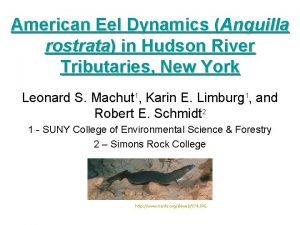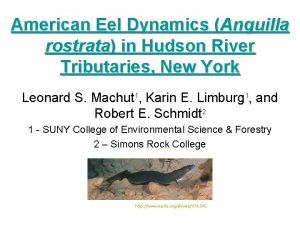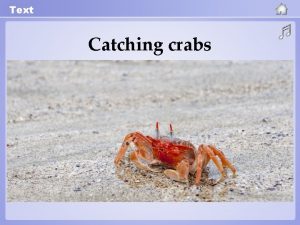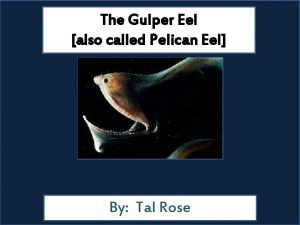Catching the Wandering Eel The American Eel Anguilla














- Slides: 14

Catching the Wandering Eel The American Eel Anguilla rostrata

Species Spotlight: The American eel, Anguilla rostrata, is the only species of freshwater eel in North America. There are two other freshwater eel species: the European eel (A. anguilla) and the Japanese eel (A. japonica)

Unique Significance: Depend on broad diversity of habitats from the ocean, estuaries and freshwater. They undergo several physical phases, known as metamorphoses through life cycle. Economically important in Atlantic Coast commercial fishing industry. First described in 1817, they have long survived many fluctuations in ocean dynamics. Juveniles, known as glass eels.

American Eel: Fish species, Anguilla, Latin for eel and rostrata, meaning curved or beaked. Has a slender, snakelike body with a long, continuous dorsal and ventral fin. Born in the ocean, mature in freshwater or estuarine habitats, and return to the ocean to spawn. This makes them catadromous fish. Can absorb oxygen through their skin and gills, allowing them to travel over land. Exhibit nocturnal behavior, hiding between rocks or buried in mud during the day and feeding on small fish, shrimp, snails, mussels and worms by night.

Natural Habitat:

Global Fishing Value: Global capture of American eel in tons from 1950 -2010

Fishery Totals: From 1950 to 2010 National Marine Fisheries Services reports: 43, 895 tons of American eel were caught for a total value of $93, 702, 486 Peak year was 1975 with 1600 tons caught. Declining to the lowest on record in 2010 to 385 tons.


Life Cycle: The life of an American eel is believed to begin and end in the Sargasso Sea. The first phase is known as: Leptocephali After fertilization the eel eggs float to the ocean surface and hatch into small transparent larvae that are shaped like willow leaves. These larvae drift with the Gulf Stream and other ocean currents, taking about a year to reach the Atlantic Coast.

Life Cycle: In the second phase the larvae develop fins and shape and are known as: Glass Eels These juveniles are transparent and are about 2 to 3 inches long.

Life Cycle: During the third phase, the eels migrate to brackish waters or through tidal rivers. They are more than 4 inches in length and known as: Elvers They begin to develop gray to green-brown pigmentation.

Life Cycle: During the fourth phase, they are not quite mature. They become Yellow Eels that are actually yellow-green to olive brown. After living for 3 to 40 or more years living in fresh water, brackish waters or marine habitat the yellow eels begin to sexually mature.

Life Cycle: In the final stage, the American eels undergo sexual differentiation, Silver Eels becoming either male or female Females can grow to 5 feet in length while the males usually reach about 3 feet. They complete sexual maturation as they return to the Sargasso Sea to spawn, where females release 20 -30 million eggs that are fertilized by males.

Good luck with catching the wandering eel! For a short video clip to view a live American eel, click below: http: //www. youtube. com/watch? v=bu. Rd. RJLp. E_Y&feature=player_embedded
 Anguilla financial services
Anguilla financial services Anguilla water corporation
Anguilla water corporation Dog catching net
Dog catching net Catching killers fire investigation
Catching killers fire investigation Poppies power and conflict
Poppies power and conflict Attitudes are contagious make yours worth catching
Attitudes are contagious make yours worth catching A deadly wandering chapter summary
A deadly wandering chapter summary 300 150 100 ekg
300 150 100 ekg A wondering mind is an unhappy mind
A wondering mind is an unhappy mind Ovary ka chitra
Ovary ka chitra Dewing wandering risk assessment tool
Dewing wandering risk assessment tool Wandering atrial pacemaker ecg
Wandering atrial pacemaker ecg Nomads are wandering people
Nomads are wandering people Wandering acetabulum
Wandering acetabulum Wandering pacemaker ecg
Wandering pacemaker ecg


























